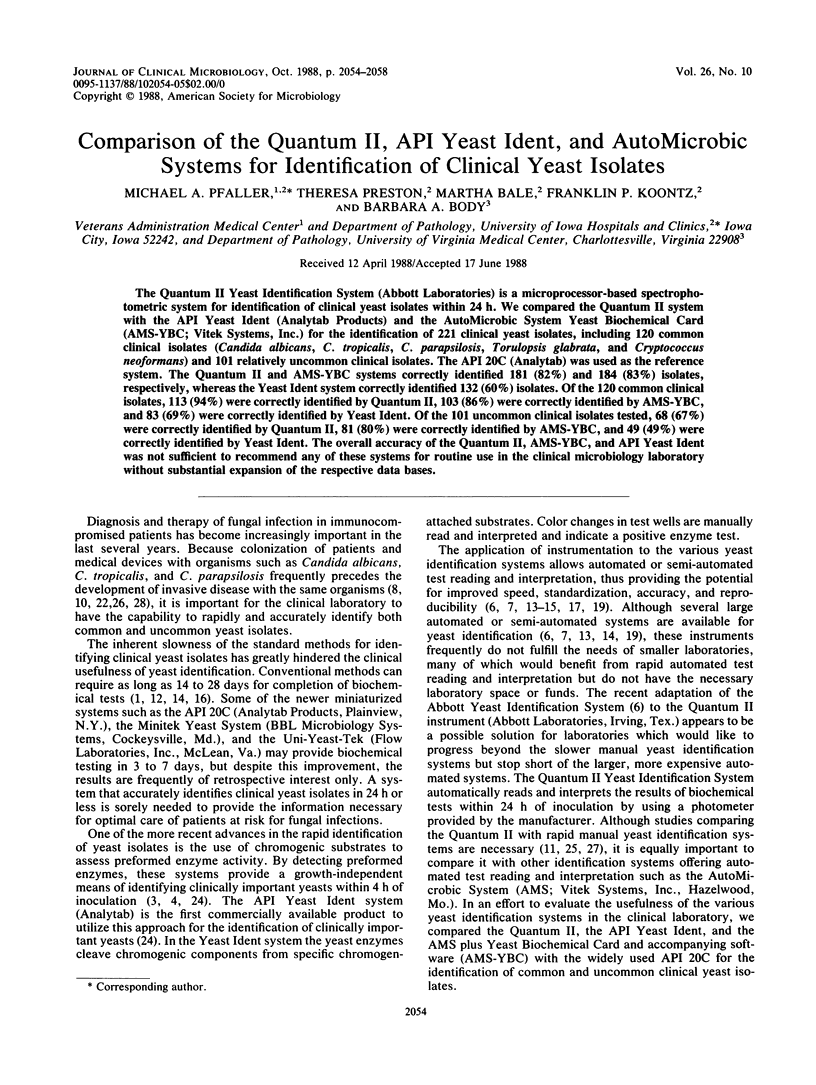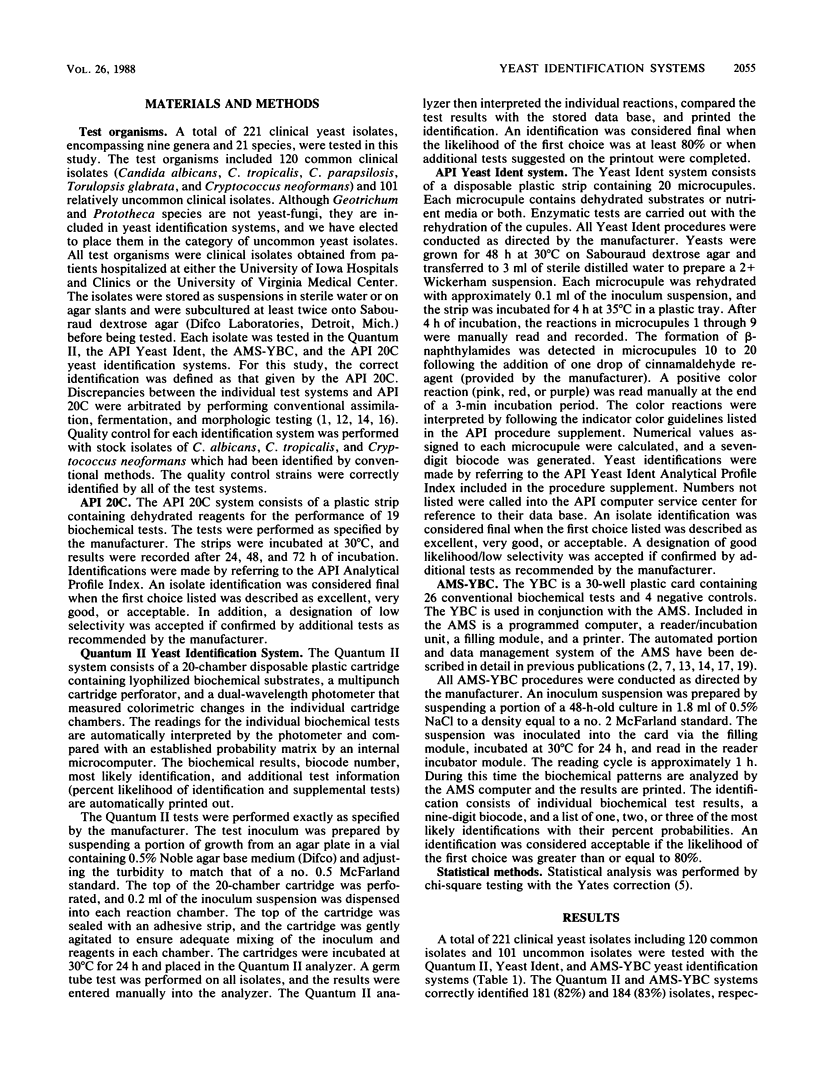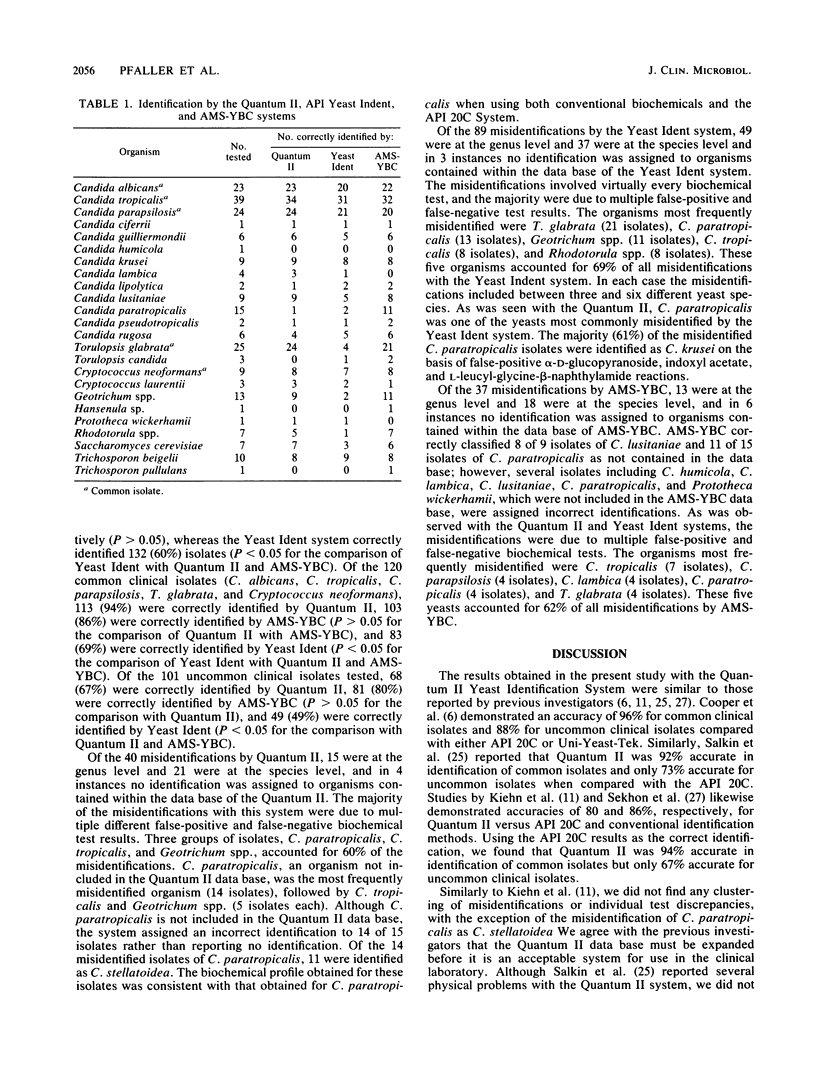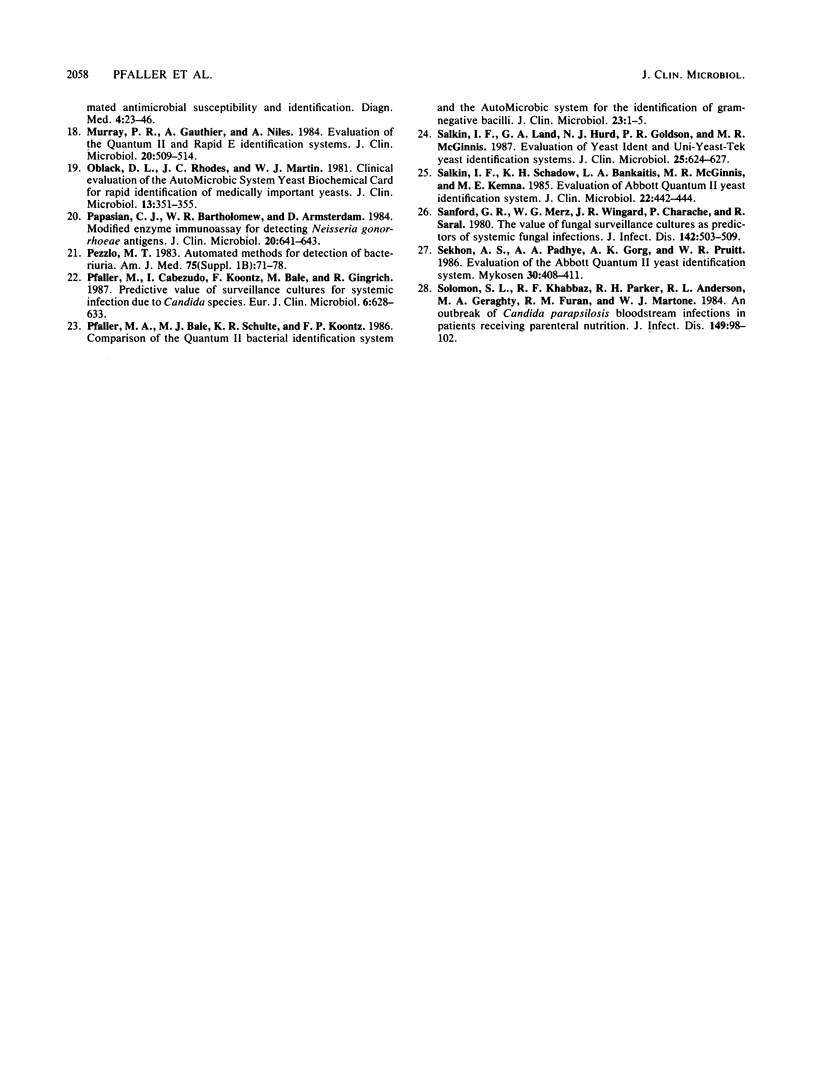Abstract
The Quantum II Yeast Identification System (Abbott Laboratories) is a microprocessor-based spectrophotometric system for identification of clinical yeast isolates within 24 h. We compared the Quantum II system with the API Yeast Ident (Analytab Products) and the AutoMicrobic System Yeast Biochemical Card (AMS-YBC; Vitek Systems, Inc.) for the identification of 221 clinical yeast isolates, including 120 common clinical isolates (Candida albicans, C. tropicalis, C. parapsilosis, Torulopsis glabrata, and Cryptococcus neoformans) and 101 relatively uncommon clinical isolates. The API 20C (Analytab) was used as the reference system. The Quantum II and AMS-YBC systems correctly identified 181 (82%) and 184 (83%) isolates, respectively, whereas the Yeast Ident system correctly identified 132 (60%) isolates. Of the 120 common clinical isolates, 113 (94%) were correctly identified by Quantum II, 103 (86%) were correctly identified by AMS-YBC, and 83 (69%) were correctly identified by Yeast Ident. Of the 101 uncommon clinical isolates tested, 68 (67%) were correctly identified by Quantum II, 81 (80%) were correctly identified by AMS-YBC, and 49 (49%) were correctly identified by Yeast Ident. The overall accuracy of the Quantum II, AMS-YBC, and API Yeast Ident was not sufficient to recommend any of these systems for routine use in the clinical microbiology laboratory without substantial expansion of the respective data bases.
Full text
PDF




Selected References
These references are in PubMed. This may not be the complete list of references from this article.
- Barry A. L., Gavan T. L., Badal R. E., Telenson M. J. Sensitivity, specificity, and reproducibility of the automicrobic system (with the Enterobacteriaceae-plus biochemical card) for identifying clinical isolates of Gram- negative bacilli. J Clin Microbiol. 1982 Apr;15(4):582–588. doi: 10.1128/jcm.15.4.582-588.1982. [DOI] [PMC free article] [PubMed] [Google Scholar]
- Bobey D. G., Ederer G. M. Rapid detection of yeast enzymes by using 4-methylumbelliferyl substrates. J Clin Microbiol. 1981 Feb;13(2):393–394. doi: 10.1128/jcm.13.2.393-394.1981. [DOI] [PMC free article] [PubMed] [Google Scholar]
- Casal M., Linares M. J. Contribution to the study of the enzymatic profiles of yeast organisms with medical interest. Mycopathologia. 1983 Mar 22;81(3):155–159. doi: 10.1007/BF00436820. [DOI] [PubMed] [Google Scholar]
- Cooper B. H., Prowant S., Alexander B., Brunson D. H. Collaborative evaluation of the Abbott yeast identification system. J Clin Microbiol. 1984 Jun;19(6):853–856. doi: 10.1128/jcm.19.6.853-856.1984. [DOI] [PMC free article] [PubMed] [Google Scholar]
- Hasyn J. J., Buckley H. R. Evaluation of the AutoMicrobic system for identification of yeasts. J Clin Microbiol. 1982 Nov;16(5):901–904. doi: 10.1128/jcm.16.5.901-904.1982. [DOI] [PMC free article] [PubMed] [Google Scholar]
- Horn R., Wong B., Kiehn T. E., Armstrong D. Fungemia in a cancer hospital: changing frequency, earlier onset, and results of therapy. Rev Infect Dis. 1985 Sep-Oct;7(5):646–655. doi: 10.1093/clinids/7.5.646. [DOI] [PubMed] [Google Scholar]
- Jones M. F., Smith T. F., Houglum A. J., Herrmann J. E. Detection of Chlamydia trachomatis in genital specimens by the Chlamydiazyme test. J Clin Microbiol. 1984 Sep;20(3):465–467. doi: 10.1128/jcm.20.3.465-467.1984. [DOI] [PMC free article] [PubMed] [Google Scholar]
- Karabinis A., Hill C., Leclercq B., Tancrède C., Baume D., Andremont A. Risk factors for candidemia in cancer patients: a case-control study. J Clin Microbiol. 1988 Mar;26(3):429–432. doi: 10.1128/jcm.26.3.429-432.1988. [DOI] [PMC free article] [PubMed] [Google Scholar]
- Kiehn T. E., Edwards F. F., Tom D., Lieberman G., Bernard E. M., Armstrong D. Evaluation of the Quantum II yeast identification system. J Clin Microbiol. 1985 Aug;22(2):216–219. doi: 10.1128/jcm.22.2.216-219.1985. [DOI] [PMC free article] [PubMed] [Google Scholar]
- Land G., Stotler R., Land K., Staneck J. Update and evaluation of the AutoMicrobic yeast identification system. J Clin Microbiol. 1984 Oct;20(4):649–652. doi: 10.1128/jcm.20.4.649-652.1984. [DOI] [PMC free article] [PubMed] [Google Scholar]
- Lin C. C., Fung D. Y. Conventional and rapid methods for yeast identification. Crit Rev Microbiol. 1987;14(4):273–289. doi: 10.3109/10408418709104441. [DOI] [PubMed] [Google Scholar]
- Malloy P. J., Miceika B. G., Ducate M. J. Automated methods in microbiology: II. Identification and susceptibility testing. Am J Med Technol. 1983 May;49(5):313–321. [PubMed] [Google Scholar]
- Mickelsen P. A., McCarthy L. R., Propst M. A. Further modifications of the auxanographic method for identification of yeasts. J Clin Microbiol. 1977 Mar;5(3):297–301. doi: 10.1128/jcm.5.3.297-301.1977. [DOI] [PMC free article] [PubMed] [Google Scholar]
- Murray P. R., Gauthier A., Niles A. Evaluation of the Quantum II and Rapid E identification systems. J Clin Microbiol. 1984 Sep;20(3):509–514. doi: 10.1128/jcm.20.3.509-514.1984. [DOI] [PMC free article] [PubMed] [Google Scholar]
- Oblack D. L., Rhodes J. C., Martin W. J. Clinical evaluation of the AutoMicrobic system Yeast Biochemical Card for rapid identification of medically important yeasts. J Clin Microbiol. 1981 Feb;13(2):351–355. doi: 10.1128/jcm.13.2.351-355.1981. [DOI] [PMC free article] [PubMed] [Google Scholar]
- Papasian C. J., Bartholomew W. R., Amsterdam D. Modified enzyme immunoassay for detecting Neisseria gonorrhoeae antigens. J Clin Microbiol. 1984 Oct;20(4):641–643. doi: 10.1128/jcm.20.4.641-643.1984. [DOI] [PMC free article] [PubMed] [Google Scholar]
- Pezzlo M. T. Automated methods for detection of bacteriuria. Am J Med. 1983 Jul 28;75(1B):71–78. doi: 10.1016/0002-9343(83)90075-x. [DOI] [PubMed] [Google Scholar]
- Pfaller M. A., Bale M. J., Schulte K. R., Koontz F. P. Comparison of the Quantum II Bacterial Identification System and the AutoMicrobic System for the identification of gram-negative bacilli. J Clin Microbiol. 1986 Jan;23(1):1–5. doi: 10.1128/jcm.23.1.1-5.1986. [DOI] [PMC free article] [PubMed] [Google Scholar]
- Pfaller M., Cabezudo I., Koontz F., Bale M., Gingrich R. Predictive value of surveillance cultures for systemic infection due to Candida species. Eur J Clin Microbiol. 1987 Dec;6(6):628–633. doi: 10.1007/BF02013057. [DOI] [PubMed] [Google Scholar]
- Salkin I. F., Land G. A., Hurd N. J., Goldson P. R., McGinnis M. R. Evaluation of YeastIdent and Uni-Yeast-Tek yeast identification systems. J Clin Microbiol. 1987 Apr;25(4):624–627. doi: 10.1128/jcm.25.4.624-627.1987. [DOI] [PMC free article] [PubMed] [Google Scholar]
- Salkin I. F., Schadow K. H., Bankaitis L. A., McGinnis M. R., Kemna M. E. Evaluation of Abbott Quantum II yeast identification system. J Clin Microbiol. 1985 Sep;22(3):442–444. doi: 10.1128/jcm.22.3.442-444.1985. [DOI] [PMC free article] [PubMed] [Google Scholar]
- Sandford G. R., Merz W. G., Wingard J. R., Charache P., Saral R. The value of fungal surveillance cultures as predictors of systemic fungal infections. J Infect Dis. 1980 Oct;142(4):503–509. doi: 10.1093/infdis/142.4.503. [DOI] [PubMed] [Google Scholar]
- Sekhon A. S., Padhye A. A., Garg A. K., Pruitt W. R. Evaluation of the Abbott Quantum II yeast identification system. Mykosen. 1987 Sep;30(9):408–411. doi: 10.1111/j.1439-0507.1987.tb03638.x. [DOI] [PubMed] [Google Scholar]
- Solomon S. L., Khabbaz R. F., Parker R. H., Anderson R. L., Geraghty M. A., Furman R. M., Martone W. J. An outbreak of Candida parapsilosis bloodstream infections in patients receiving parenteral nutrition. J Infect Dis. 1984 Jan;149(1):98–102. doi: 10.1093/infdis/149.1.98. [DOI] [PubMed] [Google Scholar]


